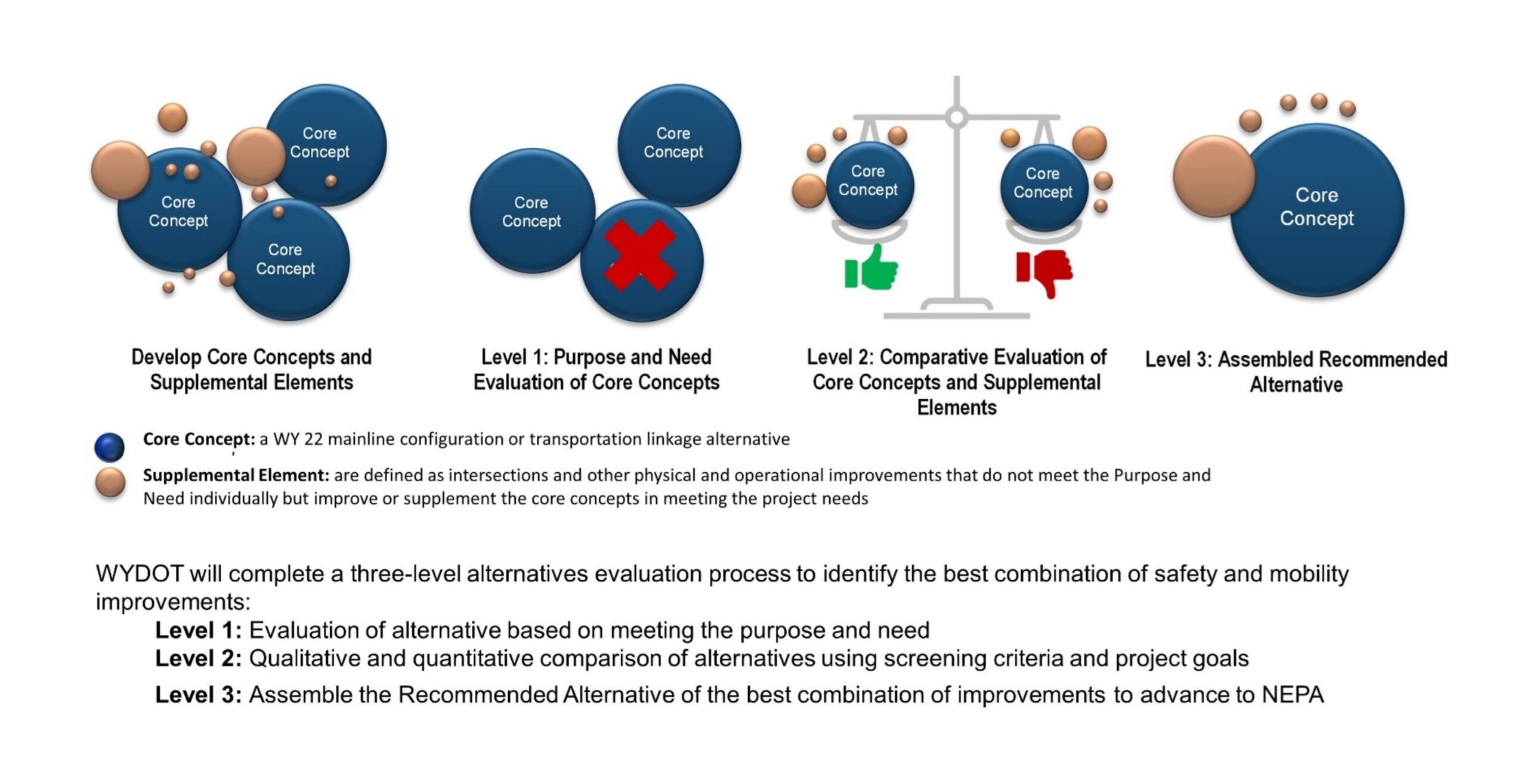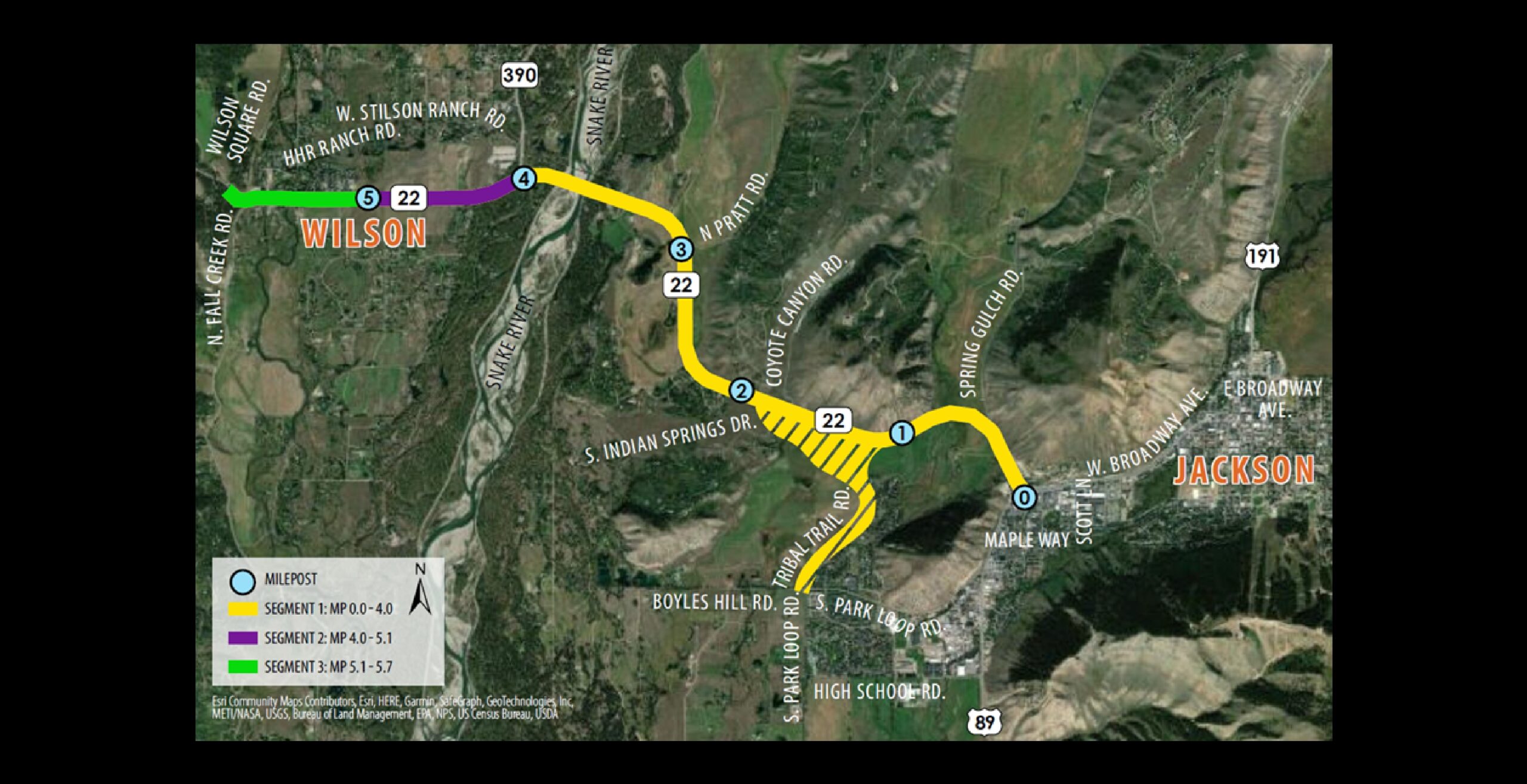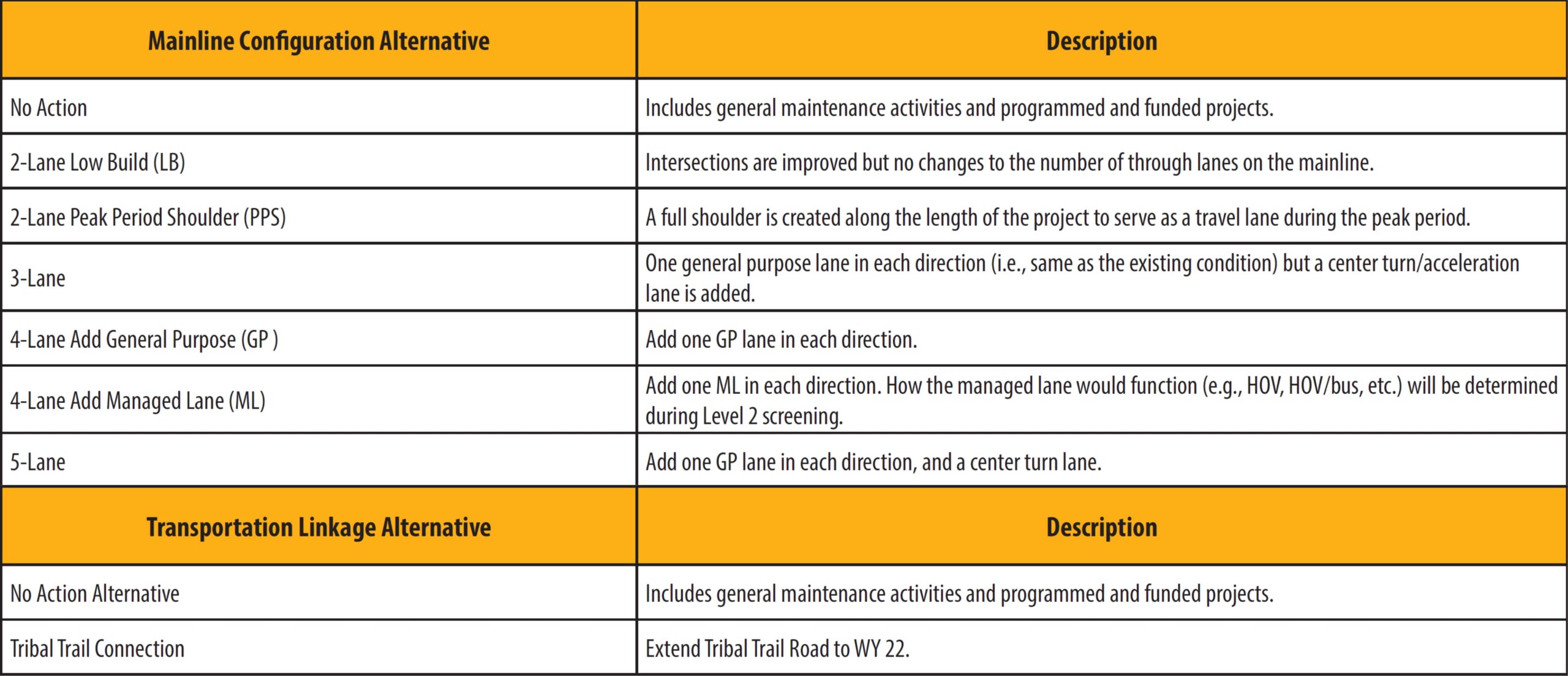ALTERNATIVES
In Fall 2023, the Project Team started the process to identify and evaluate the alternatives that best meet the project’s Purpose and Need and Project Goals.
Alternatives Evaluation Process
Before identifying alternatives, the Project Team drafted a framework to evaluate alternatives. Evaluation criteria were developed based on the Purpose and Need and Project Goals. The team met with the Project Advisory Committee (PAC) and Technical Team (TT) to discuss the framework—revising the process and criteria based on comments received.
The evaluation process involves these major steps (see Figure 1):
- Develop Range of Alternatives (core concepts and supplemental elements)
- Level 1 Screening
- Level 2 Screening
- Identify Recommended Alternative
Figure 1. Alternatives Process Flowchart

These steps are further discussed below.
RANGE OF ALTERNATIVES
To help identify alternatives, the project corridor was divided into three segments reflecting different land use and traffic characteristics (see Figure 2).
Figure 2. Project Segments

The Project Team identified improvement alternatives by reviewing planning documents and getting input from the TT, PAC, and the public during the February 2024 public meetings.
Alternatives were categorized as either core concepts or supplemental elements. Core concepts consist of WY 22 lane configuration and new transportation connections intended to meet the Purpose and Need. Supplemental elements include intersection and other improvements that do not meet the Purpose and Need individually but can improve or supplement the core concepts in meeting the project needs.
Core concepts evaluated in Level 1 include:

For a complete list of alternatives including supplemental elements, refer to the public meeting #2 exhibits and handout materials found here.
LEVEL 1 SCREENING
In Level 1, the core concepts were evaluated against the criteria at a high level to determine if they meet the Purpose and Need or have a fatal flaw. Alternatives that did not meet the Purpose and Need, or for which a fatal flaw is identified, were eliminated from further consideration. Alternatives which met the Purpose and Need were retained for Level 2 screening.
Not all core concepts were evaluated for each of the three segments. The Project team identified which alternatives to evaluate in each of the three project segments based on traffic and safety characteristics, as well as PAC input.
Segment 1: Evaluation Results
Seven mainline alternatives and two transportation linkage alternatives were evaluated in Level 1, including the No Action Alternative. Three were eliminated from further consideration:
2-Lane Low Build – this alternative was eliminated because it fails to: reduce peak period travel time delay, accommodate forecasted person trips, and improve reliable access for emergency vehicles.
Peak Period Shoulder (PPS) –eliminated because of the potential to increase crashes at intersections, failure to improve intersection operations, and failure to support travel mode choice.
3-Lane –eliminated because it fails to reduce peak period travel time delay and accommodate future forecasted person trips.
The Segment 1 alternatives that met all the screening criteria and carried forward to Level 2 analysis include:
- 4-Lane Add General Purpose
- 4-Lane Add Managed Lane
- 5-Lane
- Transportation Linkage – Extend Tribal Trail Road to WY 22
The No Action Alternative did not meet the Purpose and Need but was carried forward to Level 2 as a baseline condition for comparison.
Segment 2
Four mainline alternatives, including the No Action, were evaluated in Level 1. Only the Peak Period Shoulder alternative was eliminated because of the potential to increase crashes at intersections, failure to improve intersection operations, and failure to support travel mode choice. Alternatives that met all the screening criteria and advanced to Level 2 include:
- 2-Lane Low Build
- 3-Lane
The No Action Alternative did not meet the Purpose and Need but was carried forward to Level 2 as a baseline condition for comparison.
Segment 3
Three mainline alternatives, including the No Action, were evaluated. The Peak Period Shoulder was eliminated for the same reasons mentioned above. The Segment 3 alternatives that met all the screening criteria and were therefore carried forward to Level 2 analysis include:
- No Action
- 2-Lane Low Build
- 3-Lane Low Build
LEVEL 2A SCREENING
The Level 2A screening process aimed to determine the most effective intersection types for key locations along WY 22, considering traffic flow, safety, and future growth. The Project team conducted a comprehensive evaluation, considering over twenty different types of intersections. This analysis was conducted with input from the Project Advisory Committee (PAC), comprised of stakeholders along the WY 22 corridor, and the Jackson/Teton Transportation Advisory Committee. It evaluated major intersections along WY 22 at Broadway Avenue (the Y), Spring Gulch Road, and Tribal Trail Road/Coyote Canyon Road. For each intersection along WY 22, traffic models were developed to assess both managed lane and general-purpose lane scenarios, with and without a new intersection at WY 22/Tribal Trail Road, as well as the No Build scenario.
Based on the screening results, preliminary recommendations for the major intersections include:
- WY 22/Broadway
- Intersection concepts with raised overpasses were eliminated due to visual impacts, stakeholder input, and higher costs.
- At-grade Conventional and Florida T concepts were retained
- WY 22/Spring Gulch Road
- A roundabout concept is preferred, which would remove the existing traffic signal.
- WY 22/Tribal Trail Road/Coyote Canyon Road
- Intersection concepts connecting the extended Tribal Trail Road to the Coyote Canyon/Indian Springs intersection were dismissed due to higher impacts and stakeholder input.
- An at-grade concept adding a traffic signal at WY 22 was retained.
- Tribal Trails Road/South Park Loop Road
- A roundabout intersection concept is preferred over a conventional signal to improve vehicle and bike/ped safety
Recommendations will be finalized after public comments are received. Both general-purpose and managed lane scenarios were advanced to the Level 2B phase for further evaluation.
Minor Intersection Analysis
In addition to the major intersections, minor intersections within the project area were evaluated for the potential need for traffic signals or roundabouts. The analysis determined that traffic signals or roundabouts are not warranted at these minor intersections. During the Level 2B screening process, improvements to minor intersections such as adding deceleration or acceleration lanes, improved signage, and adjusted lane widths will be evaluated.
Upcoming Public Meeting
A public meeting will be offered this Spring to provide an opportunity for you to learn more about these alternatives and to share your input.
IDENTIFY THE RECOMMENDED ALTERNATIVE
After completing Level 2 screening, the remaining core concept(s) will be combined with the highest performing supplemental elements to form a Recommended Alternative.